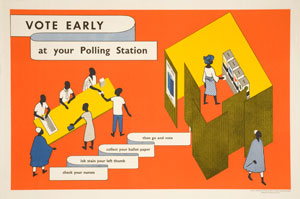International picture language collection goes on show at the Victoria and Albert Museum
Release Date 02 December 2010

Images of pictures on display at the Victoria & Albert Museum
A unique design archive showing how pictures can be used to explain complex issues to ordinary people is to be displayed at the renowned Victoria and Albert Museum in London.
‘Isotype: international picture language' runs from Friday 10 December 2010 to Sunday 13 March 2011, and is based around a collection1 housed in the Department of Typography & Graphic Communication at the University of Reading.
Isotype stands for International System of Typographic Picture Education and is a method of showing facts pictorially. Its basic elements were pictograms, simplified pictures of people or things, graphically arranged to illustrate and help explain social and economic issues.
In Britain, the Isotype approach was applied to ‘home front' publications during the Second World War, documentary films and children's books about history, science, technology and nature. In 1950s Nigeria it was used in election booklets and posters that instructed people on how and where to vote which boosted voter turn-out.
Professor Sue Walker, Dean of the University's Faculty of Arts and Humanities and one of the curators of the display, said: "The display forms part of Reading's ‘Isotype revisited' project2 which aims to show that Isotype was more than just a method of showing statistics pictorially, and that it occupies an important place in 20th-century design history. Isotype has significantly influenced the use of pictograms that we see around us today - for public signs, at sports venues, on our computers, phones and tablets. Those involved pioneered methods of transforming complicated technical information into forms easily understood by ordinary people. These are only part of Isotype's legacy to present-day information designers.
"Isotype's principal contributors, Otto Neurath, Marie Neurath and Gerd Arntz, are increasingly identified as key figures in its history. Visitors to the V&A will see examples of their work, including original exhibition charts from 1920s Vienna, posters from a 1930s tuberculosis awareness campaign in the US, and publications explaining the new welfare society in post-war Britain."
"It has been a privilege to work with colleagues at the Victoria and Albert Museum. We are particularly grateful to the Austrian Cultural Forum (London) for their keen interest and generous support."
First known as the Vienna Method, Isotype was developed by Otto Neurath and colleagues in 1920s Vienna at the path-breaking Society & Economy Museum. Through associated offices, activities and work, Isotype spread to Britain, the Netherlands, the Soviet Union and North America, and was also used to explain science, technology and history subjects.
The Isotype revisited project (isotyperevisited.org) is funded by the Arts and Humanities Research Council. For further information contact Eric Kindel (e.t.kindel@reading.ac.uk), or Sue Walker (s.f.walker@reading.ac.uk)
Ends
Further press information from James Barr, University of Reading press office, 0118 378 7115
Notes to editors:
1The Otto and Marie Neurath Isotype Collection is the most comprehensive archive of Isotype materials. It documents methods of designing and disseminating data that have played a major role in twentieth-century graphic design thinking. Given to the University of Reading by Marie Neurath in 1971, the collection includes documents, correspondence, published works, and artefacts relating to the history, principles, working methods, and products of Isotype, from its beginnings in 1920s Vienna through to its later incarnations in The Hague, Oxford, and London.
2'Isotype revisited' has several objectives. The project will review Vienna Method / Isotype approaches to pictorial language and visual education by tracking their evolving character between 1925 and 1970. In doing so, and by making known Isotype's wider sphere of activities and interests, the notion that it was concerned only with pictorial statistics will be redressed. Isotype will be further complicated by comparing its 'core' work with the efforts of adherents, imitators, and popularizers. And, in looking back from a present-day perspective, the project will consider Isotype's place in twentieth-century design history, and its influence on graphic communication today.
For over thirty years, the University of Reading's Department of Typography & Graphic Communication has been the only one of its kind in Britain. It offers a unique approach to design through a combination of practice, theory and history. Teaching is augmented by funding through CETL and the excellent special collections and archives held in the Department
The high standard and diversity of research in the Department are recognized by our result in RAE 2008, with 80 per cent of research being rated world-leading or internationally excellent. They are also reflected in undergraduate and postgraduate programmes, as well as in works published by the Department, such as Typography Papers.
The Victoria & Albert Museum is the world's leading museum of art and design with collections unrivalled in their scope and diversity. It was established to make works of art available to all and to inspire British designers and manufacturers. Today, the V&A's collections, which span over 2000 years of human creativity in virtually every medium and from many parts of the world, continue to intrigue, inspire and inform. www.vam.ac.uk
The Arts and Humanities Research Council (AHRC) supports world-class research that furthers our understanding of human culture and creativity. Each year the AHRC provides approximately £112 million from the Government to support research and postgraduate study in the arts and humanities, from languages and law, archaeology and English literature to design and creative and performing arts. In any one year, the AHRC makes approximately 700 research awards and around 1,350 postgraduate awards. Awards are made after a rigorous peer review process, to ensure that only applications of the highest quality are funded. The quality and range of research supported by this investment of public funds not only provides social and cultural benefits but also contributes to the economic success of the UK. See: www.ahrc.ac.uk
